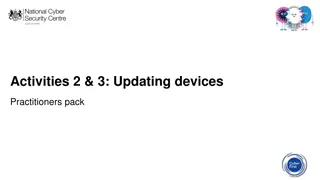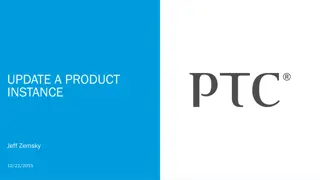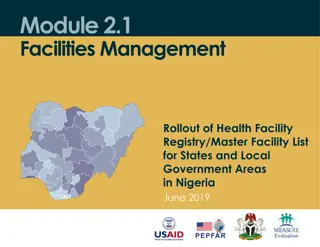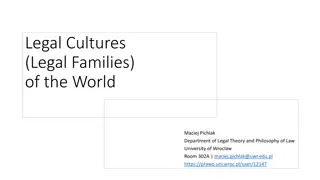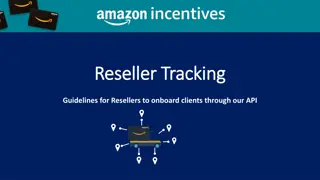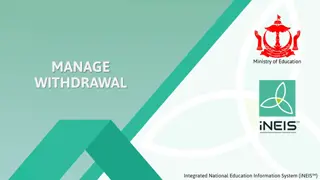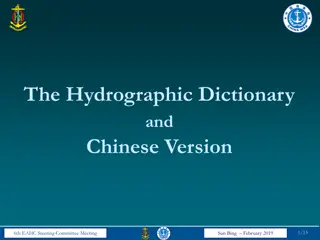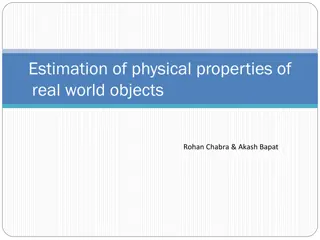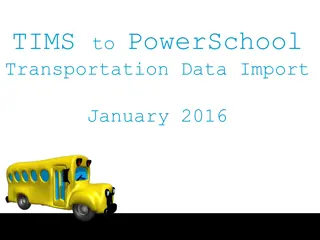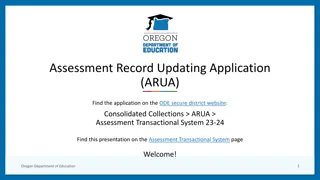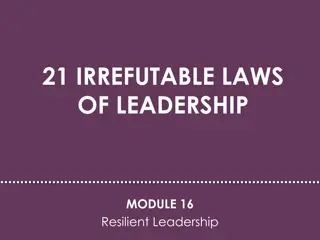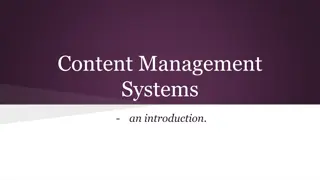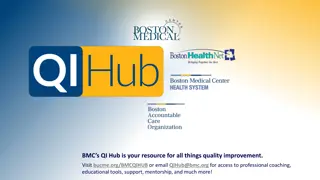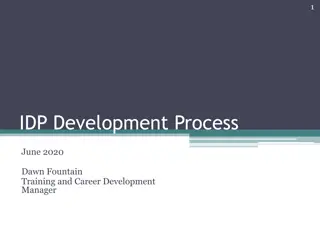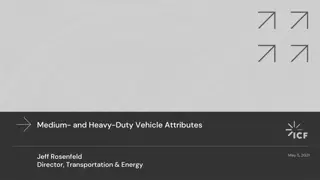Overview of Tracking and Updating the Law Process
Understanding the process of tracking and updating laws is essential for legal professionals to stay informed and compliant. This involves searching for updates, collecting relevant laws, creating legal texts, coding new iterations, ensuring quality control, updating publication documents, and republishing projects. Researchers need to review coding questions, familiarize themselves with the project scope and search terms, and verify legislative sessions for jurisdictions. Additionally, using master sheets to collect and verify citations of relevant laws is crucial for staying up to date with recent amendments.
Download Presentation

Please find below an Image/Link to download the presentation.
The content on the website is provided AS IS for your information and personal use only. It may not be sold, licensed, or shared on other websites without obtaining consent from the author. Download presentation by click this link. If you encounter any issues during the download, it is possible that the publisher has removed the file from their server.
E N D
Presentation Transcript
Tracking and Updating the Law LEARNING LIBRARY FEBRUARY 2022
Learning objectives Define tracking and updating the law Learn the steps to track and update the law 1. Search for updates 2. Collect the law 3. Create the legal text 4. Code new iterations 5. Quality control and updating 6. Update publication documents 2
Tracking and updating the law consists of periodically checking for new laws and updates to existing laws that are included in a project Defining tracking and updating the law
Steps in tracking and updating the law 1 Search for updates 2 Collect the law 3 Create the legal text 4 Code new iterations 5 Quality control 6 Update publication documents 7 Republish project
Review the projects coding questions Read the research protocol, which includes information on: 1. Search for updates Researchers familiarize themselves with the project The scope of the dataset, Search terms that will be used to conduct research, and Definitions of terms of art
1. Search for updates Verify which jurisdictions have been in legislative session since the last update Check for new laws or amendments in jurisdictions that had a legislative session since the last update
Using citations listed on master sheets Citations of relevant laws in a jurisdiction are collected in a Master Sheet document There is one Master Sheet per jurisdiction Master Sheet should include: Alaska Master Sheet Alaska Stat. 12.55.035 Fines 3rd Sp. Sess. 2012, ch.1, 19 The citation and title of each law o Effective July 1, 2012 SLA 2016, ch. 36 72 o Effective October 9, 2016 The statutory history for each law And the effective dates 7
Using citations listed on master sheets Verify whether laws listed on the current Master Sheet for each jurisdiction have recent amendments, and update the Master Sheet accordingly Start by entering each citation on the Master Sheet into a legal search engine such as Westlaw or LexisNexis When a law has an amendment, add that amendment to the Master Sheet 8
Search for updates: example ALASKA STAT. 12.55.035 CREDIT HISTORY ALASKA MASTER SHEET Update Master Sheet based on new amendment Most recent amendment on Master Sheet
Using search terms recorded on research protocol The researcher should use the search terms listed on the research protocol document to find any relevant laws that have been enacted since the last update This search can be done on any legal search engine, such as Westlaw or LexisNexis New laws should be added to the master sheet along with their statutory histories and effective dates 10
When a new law or amendment is enacted, it must be collected from an unencumbered source Unencumbered sources can include state legislative websites 2. Collect the law Using an unencumbered source to collect new laws
The legal text is the organized version of the relevant law for a jurisdiction: Legal assessment (cross-sectional) one legal text, for one jurisdiction, at one point in time Policy surveillance (longitudinal) multiple legal texts, for one jurisdiction, over a period of time The legal text is used to code the law 3. Create the legal text Defining legal text
Three types of documents are used to create the legal text: The master sheet The amendment tracker Individual laws In this step, you will learn how to use the amendment tracker and master sheet to create the legal text that will be used to code 3. Create the legal text Documents used
The amendment tracker document: List amendments to relevant laws in one jurisdiction, in chronological order Created to serve as a guide when creating a policy surveillance project and updating a legal assessment project 3. Create the legal text Defining amendment tracker
Creating the legal text: for policy surveillance projects or for updating legal assessments MASTER SHEET CITATIONS FULL LEGAL TEXT FOR MAY 11, 2012 Alaska Stat. 12.55.035 Fines SLA 2010, ch. 110, 1, 4 Effective September 26, 2010 3rd Sp. Sess. 2012, ch. 1, 19 Effective July 1, 2012 Alaska Stat. 28.01.010 Provisions uniform throughout state SLA 2010, ch. 29, 38 Effective July 1, 2010 Alaska Stat. 28.35.161 Use of electronic devices while driving; unlawful installation of television, monitor, or similar device SLA 2009, ch. 42, 1 Effective September 18, 2009 SLA 2012, ch. 14, 2-5 Effective May 11, 2012 Alaska Stat. 12.55.035 Fines (no changes) (a) Upon conviction of an offense, a defendant may be sentenced to pay a fine as authorized in this section or as otherwise authorized by law .. Alaska Stat. 28.01.010 Provisions uniform throughout state (no changes) (a) The provisions of this title and the regulations adopted under this title are applicable within all municipalities of the state. .. Alaska Stat. 28.35.161 Use of electronic devices while driving; unlawful installation of television, monitor, or similar device (2012 Amendment, ch. 14 2-5) (a) A person commits the crime of driving while texting, while communicating on a computer, or while a screen device is operating if the person is driving a motor vehicle, and AMENDMENT TRACKER Iteration Date Amendment Changes 2. May 11, 2012 Alaska Stat. 28.35.161 ch. 14, 2-5; added texting ban to (a); adjusted internal reference; changed verbal to voice in subsection (c); added text to emergency use provision in subsection (d)
Creating the legal text FULL LEGAL TEXT FOR MAY 11, 2012 At this stage of the process, you have checked for updates, and have fully built the legal text that will be used to answer the coding questions. Alaska Stat. 12.55.035 Fines Upon conviction of an offense, a defendant may be sentenced to pay a fine as authorized in this section or as otherwise authorized by law .. Alaska Stat. 28.01.010 Provisions uniform throughout state The provisions of this title and the regulations adopted under this title are applicable within all municipalities of the state. .. Alaska Stat. 28.35.161 Use of electronic devices while driving; unlawful installation of television, monitor, or similar device A person commits the crime of driving while texting, while communicating on a computer, or while a screen device is operating if the person is driving a motor vehicle, and 17
4. Code new iterations Coding the law consists of using the legal text collected to answer the questions developed Module 3 Module 4 Module 5 Code answers to questions based on collected law Collect laws Develop questions 18
Coding example QUESTION LEGAL TEXT RESPONSE Alaska Stat. 28.35.161 Use of electronic devices while driving; unlawful installation of television, monitor, or similar device What behaviors are restricted while driving? (a) A person commits the crime of driving while texting, while communicating on a computer, or while a screen device is operating if the person is driving a motor vehicle, and (2) the person is reading or typing a text message or other nonvoice message or communication on a cellular telephone, personal data assistant, computer, or any other similar means capable of providing a visual display that is in view of the driver in a normal driving position while the vehicle is in motion and while the person is driving A. Handheld electronic messaging Handheld calling Hands-free electronic messaging Hands-free calling A. Handheld electronic messaging B. C. D. 19
Code new iterations Iteration 2: Iteration 1: October 28, 2013 January 1, 2016 December 1, 2001 - October 27, 2013 NY VEH & TRAF 1225-c Use of mobile telephones [ ] NY VEH & TRAF 1225-c Use of mobile telephones [ ] 4. A violation of subdivision two of this section shall be a traffic infraction and shall be punishable by a fine of not less than fifty dollars nor more than one hundred fifty dollars upon conviction of a first violation 4. A violation of subdivision two of this section shall be a traffic infraction and shall be punishable by a fine of not more than one hundred dollars. Q: What is the maximum penalty for a violation? Q: What is the maximum penalty for a violation? A: One hundred fifty dollars A: One hundred dollars 20
Update the valid-through date When updating a jurisdiction, the latest coding iteration should indicate when laws were researched so the team knows the dates these laws are guaranteed to be valid This should be done even when a jurisdiction has no amendments or new laws that have been enacted. It indicates that the law has been checked for updates up to that point in time 21
When performing updates, the same quality control measures that are used in the original creation of the policy surveillance process should be applied The following measures should be implemented: Redundant research Redundant coding Final quality control check When assigning redundant coding in an update, the first five iterations to receive an update are redundantly coded 20% of any subsequent records are redundantly coded The updated iteration is compared with the coding of the last iteration for each jurisdiction, to ensure that the coding in the update is consistent with the original coding 5. Quality control
6. Update publication documents When re-publishing a project following an update, any ancillary publication documents, such as the data file for your project, should be updated.
Upon the completion of an update, the project should be re-published on whatever dissemination outlet was initially used. LawAtlas.org Internally 7. Re-publish project
Summary Updating the law includes the following steps: 1. Search for updates Researchers familiarize themselves with the project Verify which jurisdictions have been in legislative session since the last update Using citations listed on master sheets Using search terms recorded on research protocol 2. Collect the law Use an unencumbered source to collect new laws 3. Create the legal text 4. Code new iterations 5. Quality control 6. Update publication documents 7. Re-publish project 25

